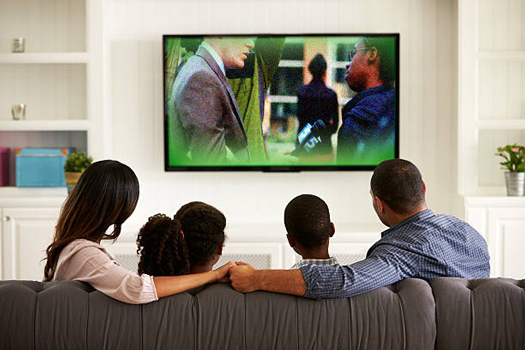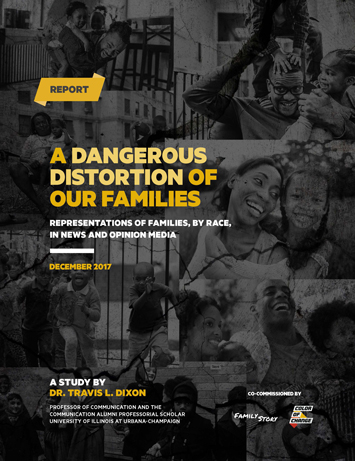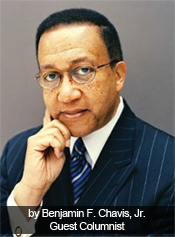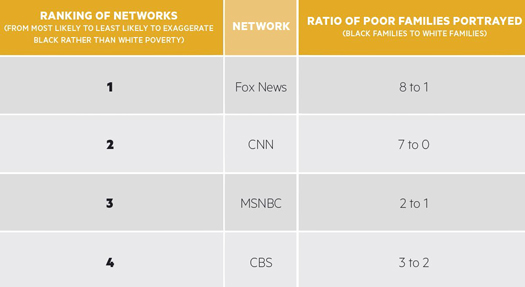Study: Mainstream pushes false, damaging stereotypes about Black families
By Barrington M. Salmon -Contributing Writer- | Last updated: Jan 1, 2018 - 3:05:10 PMWhat's your opinion on this article?

|
For much of the sojourn of Africans in America, neither the United States government, nor most of its citizens, have quite figured how to reconcile America’s original sin—slavery—or the place formerly enslaved Africans and people of color fit in the United States.
Blacks and Whites continue to live in an uneasy peace.

|
That time period, January 2015 to December 2016, encompasses the rise of New York real estate magnate Donald Trump to become the Republican nominee for president and his virulent, overtly racist campaign that scapegoated Blacks, Latinos and other non-Whites. In the aftermath of Mr. Trump’s election, his Republican supporters, as well as a wide swathe of other Whites, have felt more comfortable expressing their racial animus and hostility.
Negative media depictions of Blacks as individuals and families helped fuel these feelings. Rashad Robinson of Color of Change, the nation’s largest online racial justice organization, and Nicole Rodgers of Family Story, an organization dedicated to elevating stories of diverse families, say media depictions put Black families in a particularly unfavorable light.

|
“We see these distortions and inaccuracies not only in right-wing outlets like Breitbart, but in unexpected places like the New York Times and like Meet the Press—and they have grave consequences. Not only are these systemic patterns in news coverage simply inaccurate, but they also harm American families by justifying federal and state policies that will doom American families for generations to come.”
Ms. Rodgers agreed.
“News and opinion media continue to reinforce the unfounded and unfair idea that Black families are sources of personal, cultural and societal instability and that they are responsible for poverty, welfare and crime, rather than those who shape the economic and social environment families live in,” said Ms. Rodgers, founder and executive director of Family Story. “It is not just the glut of negative representations that hurt Black families; it is also the absence of positive ones.”
“This is even more striking if you consider how consistently news and opinion media advance White families as models of social stability. These portrayals reinforce the implicit bias people already have about racial difference, which inform behaviors and attitudes that show up in all aspects of our lives, including at the voting booth.”

|
“For 191 years, since the publication of the Freedom’s Journal in 1827, the Black Press has always had to confront the negative stereotypes, images and myths of people of African descent in America and throughout the world,” said Dr. Chavis, president and CEO of the National Newspaper Publishers Association. “This latest round of the destruction of Black family life through images and the written word is nothing new, but a reassertion of the tenets of White supremacy.”
He said the NNPA will always challenge the distortions and encourage the 47 million Black Americans that they should not be dissuaded by false stories and destructive images.
“We live in a world and society were the fundamental right to self-determination and self-identification is a right that Black Americans will never give up,” Dr. Chavis said. “And this position is more valuable because of where the Black Press stands.”
Mr. Robinson, in the foreword of the report, said that from its inception, activists with Color of Change worked to highlight how local and national news both intentionally and incidentally inject harmful bias into public opinion. The organization challenged Fox News, he said, and pushed to get what he describes as “misinformation zealots” like Glenn Beck and Bill O’Reilly off the air. In addition, the organization placed a spotlight on conditions in New York local news rooms which were found to inaccurately over-associate Black people with crime by 75 percent.
The report, he said, is “an important canon to reference, as we continue to unpack the various elements and cultural conditions that enabled the election of politicians—from the presidency to governors and others—who exploit good ol’ boy dog whistle rhetoric, masquerading as economic populism.”
“There is no question that the right wing has exploited the unwritten rules of media reporting and coverage to change the written rules of policy. And, destructively they have not only their own media platforms but also influence over purportedly neutral and evenhanded news outlets across the country to do it.”

|
Ms. Rodgers and Mr. Robinson spoke of the political and social implications of this bias.
“Until now, no research has systematically explored racialized differences in how news and opinion media represent families. Of course, we know intuitively that disparities exist,” she said. “After all, what’s the difference between having a ‘blended family’ (hail! the future of family) and having multiple ‘baby daddies’ (ack! the downfall of society)? It’s not just the structure of the family; it’s the race of the family. We often measure ‘good families’ in colors.”
“When a four-year-old Black boy fell into the gorilla habitat at the Cincinnati Zoo in 2016, media outlets were quick to focus attention on the criminal history of the boy’s Black father, an unrelated detail that served no discernible purpose other than to invoke a stereotype that would criminalize the whole family and thereby justify blaming them for the tragic event,” Ms. Rodgers said. “But when a two-year-old White boy was snatched up by an alligator in front of his parents just a week later at a Disney resort, there was no media scrutiny of the parents and a vastly more empathic response overall. This is typical of a widespread pattern of racially biased reporting and racially biased norm-setting, which this report expands on in detail.”
Dr. Chavis, Ms. Rodgers and Mr. Robinson said that from a historical standpoint, it is no accident that media portrayals continue to “pump out a distortion in the representation of poverty, which paints a picture not just of poor, Black families as a drain on the system, but also systematically ignores providing context on their resiliency in the face of the tides these families are swimming against, tides that are out of their control and put them in harm’s way, often as a result of corporate or conservative decision-makers using them as leverage for profit and politics.”
Dr. Shantella Sherman, a Washington, D.C.-based historian said she thinks that the energy of Black Americans would be better served by focusing on strengthening Black publications.
“At the turn of the last century and before, Black newspapers worked on telling their own stories,” said Dr. Sherman, a journalist, author and publisher of ACUMEN magazine. “Newspapers had Pan Africanists, Jamaicans, Africans and others who wrote about what was important to us and why. We had someone doing the socialite page and preachers worked there. Journalists were taught to sculpt words, whether in newsprint or on the radio. You might not have liked Garvey or Dubois, but you read their publications.”
“Black people had a UNIA card, an NAACP card, were members of a church and they joined organizations and clubs that specifically helped Black people. They also joined organizations because they never knew where their help might come from. You understood having to give money to the church to help those in need and in a lot of cases, the church was a venue for organizations because we knew that we couldn’t expect any help from White people. We’re looking at a situation now where White people are using the same ol’ grown up, tore down, ripped up playbook on race and calling us racist.”
“The real issue with Black people is that I’m not sure they believe in their power, worth or value anymore. I’m not sure that they have the fight. But they need to invest in Black newspapers and publications. If they don’t, we won’t have the pens, food or ammunition to fight. I go out to report on stories and people don’t want to talk to reporters from Black newspapers, they demean them and talk down to them. I can’t tell you how many times that has happened to me,” said Dr. Sherman.
“This is less a conversation about what White people are doing and more about our responsibility and accountability to our community. We’ve got to go back to basics. We need newsrooms with diversity and staffs with integrity. We need to talk about lynchings, what White men are doing and risk being firebombed. I’m not seeing community engagement, intellectual articles and columns or deep investigative pieces about issues of concern to African Americans from the majority of Black newspapers.”
Dr. Sherman said she doesn’t expect much from White media because they don’t live in Black communities or move around in Black spaces. Building self-sufficiency and independence will be key going forward.
“I see 2018 as bring own-ness into our lives,” she said. “If Black people subscribed to newspapers that would make a huge difference. Why can’t people support The Final Call or the farms the Nation (of Islam) used to have? It’s all in how we see ourselves to destroy stereotypes. The beauty of The Final Call is that they are not afraid to speak truth. They’re not beholden to the government or corporations and they’re not afraid to ruffle feathers. The Final Call has the reputation that you know they’re going to tell the truth and won’t change or omit things you say. The public trusts that and their words are power that can take down governments.”
INSIDE STORIES AND REVIEWS
-
-
About Harriett ... and the Negro Hollywood Road Show
By Rabiah Muhammad, Guest Columnist » Full Story -
Skepticism greets Jay-Z, NFL talk of inspiring change
By Bryan 18X Crawford and Richard B. Muhammad The Final Call Newspaper @TheFinalCall » Full Story -
The painful problem of Black girls and suicide
By Charlene Muhammad -National Correspondent- » Full Story -
Exploitation of Innocence - Report: Perceptions, policies hurting Black girls
By Charlene Muhammad -National Correspondent- » Full Story -
Big Ballin: Big ideas fuel a father’s Big Baller Brand and brash business sense
By Bryan Crawford -Contributing Writer- » Full Story






 Click Here Stay Connected!
Click Here Stay Connected!








